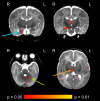Computer-controlled stimulation for functional magnetic resonance imaging studies of the neonatal olfactory system
- PMID: 23789919
- PMCID: PMC3795441
- DOI: 10.1111/apa.12327
Computer-controlled stimulation for functional magnetic resonance imaging studies of the neonatal olfactory system
Abstract
Aim: Olfactory sensation is highly functional early in human neonatal life, with studies suggesting that odours can influence behaviour and infant-mother bonding. Due to its good spatial properties, blood oxygen level-dependent (BOLD) contrast functional magnetic resonance imaging (fMRI) has the potential to rapidly advance our understanding of the neural activity which underlies the development of olfactory perception in this key period. We aimed to design an 'olfactometer' specifically for use with neonatal subjects for fMRI studies of odour perception.
Methods: We describe a fully automated and programmable, fMRI compatible system capable of presenting odorant liquids. To prevent contamination of the system and minimize between-subject infective risk, the majority of the olfactometer is constructed from single-use, readily available clinical equipment. The system was used to present the odour of infant formula milk in a validation group of seven neonatal subjects at term equivalent postmenstrual age (median age 40 weeks).
Results: A safe, reliable and reproducible pattern of stimulation was delivered leading to well-localized positive BOLD functional responses in the piriform cortex, amygdala, thalamus, insular cortex and cerebellum.
Conclusions: The described system is therefore suitable for detailed studies of the ontology of olfactory sensation and perception during early human brain development.
Keywords: Infant; Newborn; Olfactory; fMRI.
©2013 Foundation Acta Paediatrica. Published by John Wiley & Sons Ltd.
Figures




References
-
- Schneider NY, Fletcher TP, Shaw G, Renfree MB. The olfactory system of the tammar wallaby is developed at birth and directs the neonate to it mother’s pouch odors. Reproduction. 2009;138:849–57. - PubMed
-
- Stickrod G, Kimble D, Smotherman W. In utero taste/odor aversion conditioning in the rat. Physiol Behav. 1982;28:5–7. - PubMed
-
- Best AR, Wilson DA. A postnatal sensitive period for plasticity of cortical afferents but not cortical association fibers in rat piriform cortex. Brain Res. 2003;961:81–7. - PubMed
Publication types
MeSH terms
Grants and funding
LinkOut - more resources
Full Text Sources
Other Literature Sources
Medical

